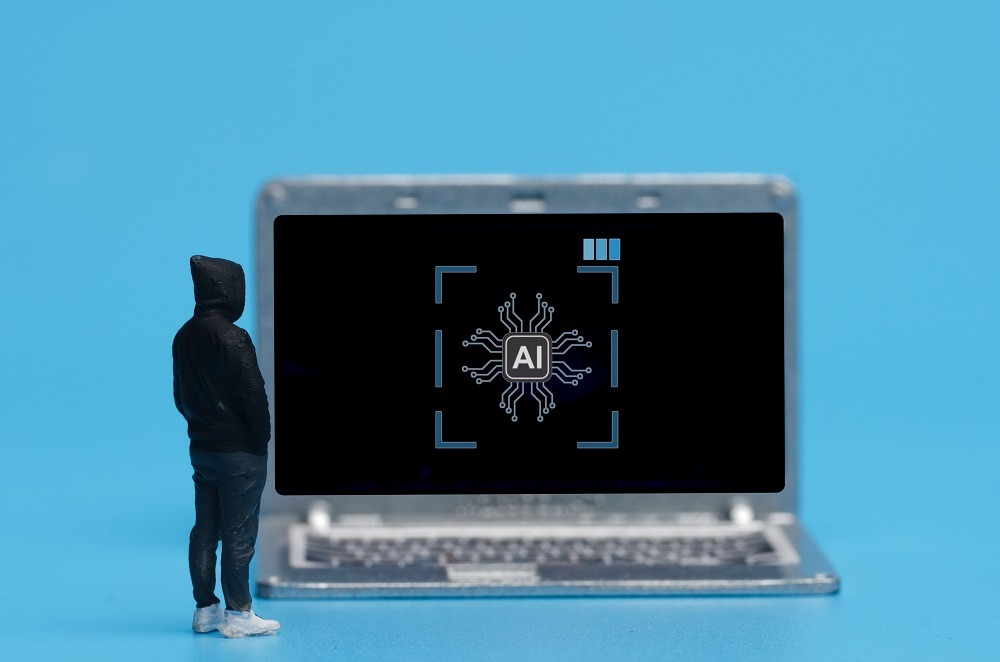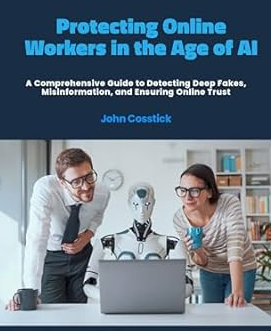Welcome to the future of cybersecurity, where artificial intelligence (AI) is no longer just a buzzword but a revolutionizing force reshaping the digital battlefield, changing future diections. In today’s interconnected world, cyber threats are more pervasive and sophisticated than ever, targeting individuals and organizations alike.

A picture of men miniature with laptop with artificial intelligence sign
The stakes couldn’t be higher, as cyberattacks can lead to devastating financial losses, reputational damage, and compromised sensitive data. But fear not, for AI is emerging as a powerful ally in this ongoing battle. Imagine systems capable of analysing vast amounts of data in real-time, detecting anomalies, and adapting to evolving threats – all without human intervention.
This is the promise AI brings to cybersecurity: the ability to predict attacks before they occur and respond effectively when they do. Let’s dive into how AI is revolutionizing how we protect ourselves in an increasingly digital world.
Cybersecurity Trends for 2025 and Beyond-IBM Technology
The Escalating Cyber Threat Landscape
Cyberattacks are becoming more frequent and sophisticated, posing serious risks to businesses and individuals. With each new device connected to the internet, attackers gain more entry points, exploiting vulnerabilities with tactics ranging from ransomware to phishing schemes.
High-profile breaches regularly make headlines, underscoring how ill-prepared many organizations are. Even small businesses, often lacking robust security measures, are not immune to these threats. The consequences of cyberattacks can be devastating, resulting in financial losses, reputational damage, and compromised data that can take years to recover. This growing menace highlights the urgent need for immediate and proactive strategies in combating cyber threats.
Top FBI official warns Americans about new scams and how to protect yourself – ABC News
In the Age of AI businesses must follow a cybersecurity blog and news service. Here is one provider for which we are affiliates – Heimdal Security.
If you wish to follow the Heimdal Security blog, click HERE. If you have concerns about your business’s cybersecurity, click HERE. As a first step, they will help you get a free assessment of your defenses and then explain in greater detail how their solution works
AI: A Game Changer in Cybersecurity
AI is revolutionizing cybersecurity by introducing advanced threat detection and response capabilities. Traditional methods often struggle to manage the sheer volume of data and the ever-changing tactics of cybercriminals. However, AI excels in these areas.
By analysing patterns at lightning speed, AI algorithms can detect anomalies that might otherwise go unnoticed. Machine learning models continuously improve over time, learning from past attacks to predict potential threats and proactively mitigate risks. However, it’s important to note that AI is not a replacement for human oversight.
It is hard to believe that AI could now clone a human voice to facilitate scams to mislead a close relation to obtain funds by fraud, but it is now true. To view a YouTube video from Heimdal Security that reveals how this is done click HERE.
Human expertise is crucial in interpreting AI’s findings and making strategic decisions. AI also enhances incident response by automating the isolation of affected networks or devices, minimizing damage and downtime. Tools powered by natural language processing can analyze user behavior and communications, identifying phishing attempts and social engineering attacks.
These innovations, when combined with human oversight, empower businesses to navigate the increasingly complex cybersecurity landscape and protect sensitive information more effectively.
AI in Cybersecurity – IBM Technology
The Benefits and Limitations of AI in Cybersecurity
AI offers a plethora of benefits in the realm of cybersecurity. It can quickly process vast amounts of data, identifying threats that human analysts might miss. This rapid analysis enables faster response times, reducing the impact of attacks. Machine learning models evolve continuously, adapting to new tactics used by cybercriminals. Moreover, routine task automation frees security teams to focus on more complex issues.
However, AI systems are not perfect. They can produce false positives or fail to detect subtle threats. Over-reliance on AI might lead organizations to overlook valuable insights from human expertise. Furthermore, cybercriminals are also leveraging AI to create more sophisticated attacks, escalating the arms race in cybersecurity. Despite these challenges, integrating AI into cybersecurity remains a critical step forward. It is important to remember AI’s dependency on data quality and that human oversight is critical.
AI and Its Impact on Cybersecurity – SANS Institute
AI-Powered Disinformation: A New Battlefront
Unfortunately, AI’s increasing sophistication has opened a new door for malicious actors to spread disinformation and conduct social engineering attacks. AI algorithms can now generate incredibly realistic fake videos, audio recordings, and even social media profiles, making it increasingly difficult to distinguish between factual and fabricated content.
This poses a significant threat to individuals and organizations alike, as these AI-generated fakes can be used to manipulate public opinion, damage reputations, and steal sensitive information. The rise of AI-powered disinformation and social engineering requires a concerted effort to develop new detection methods and educate the public on identifying and protecting themselves from these evolving threats. We have produced this eBook,
The Vulnerability of AI: Adversarial Attacks
While AI offers powerful tools for cybersecurity, it is essential to recognize that AI models are not immune to attacks. Cybercriminals are constantly exploring new ways to exploit vulnerabilities in AI systems, employing adversarial attacks. These attacks involve manipulating the input data fed to an AI model, causing it to misclassify information or make incorrect predictions.
For instance, attackers could subtly alter an image or audio file in a way that is imperceptible to humans but causes an AI system to misidentify it, potentially leading to security breaches. Understanding and mitigating the vulnerability of AI models to adversarial attacks is not just important, it’s crucial for ensuring the long-term effectiveness of AI-driven cybersecurity solutions.
Will AI Help or Hurt Cybersecurity? Definitely!–IBM Technology
The Need for Transparency: Explainable AI
As AI systems become more complex and their decision-making processes become less transparent, the need for explainable AI (XAI) in cybersecurity becomes increasingly urgent. XAI aims to provide insights into how AI models arrive at their conclusions, making their decisions more understandable and trustworthy for security analysts.
This transparency is not just beneficial, it’s crucial for several reasons. First, it allows analysts to identify and correct biases or errors in the AI’s decision-making process. Second, it helps build trust in the AI system, encouraging its adoption and effective use. Finally, XAI can help ensure accountability, making it easier to determine who is responsible when an AI system makes an error or fails to detect a threat.
We consider that Explainable AI (XAI) is worthy of having a dedicated website, Go2XAI.com. Do you agree? Let us know your thoughts in the comments section below.
What is Explainable AI? By Google Cloud Tech
Securing the Internet of Things: The AI Advantage
The rapid proliferation of Internet of Things (IoT) devices presents a unique set of security challenges that AI is well-suited to address. IoT devices, ranging from smart home appliances to industrial sensors, often have limited processing power and lack traditional security measures, making them vulnerable to cyberattacks.
AI can play a crucial role in securing these devices by analysing the data they generate, identifying anomalies, and detecting potential threats in real-time. For example, AI algorithms can learn the standard behaviour patterns of IoT devices and alert users or security teams to any deviations that could indicate a compromise. Additionally, AI can help automate security updates and patch management for IoT devices, ensuring they remain protected against emerging threats.
Webinar: The role of Artificial Intelligence in IoT – Telenor IoT
AI: The Cybercrime Investigator
AI is becoming an increasingly valuable tool for law enforcement agencies in investigating and prosecuting cybercrime. The sheer volume of data generated in cyberattacks can overwhelm human investigators, but AI algorithms can efficiently sift through this data, identify patterns, and uncover crucial evidence.
AI can also track the flow of stolen funds, identify suspects, and predict future cybercriminal activity. By automating routine tasks and providing insights into complex cybercrime operations, AI empowers investigators to work more efficiently and effectively, ultimately leading to a safer digital environment.
Quantum Computing and AI: A New Era of Cybersecurity
The advent of quantum computing poses challenges and opportunities for AI in cybersecurity. On the one hand, quantum computers have the potential to break current encryption methods, rendering many existing security measures obsolete. This could have devastating consequences for individuals, businesses, and governments alike.
On the other hand, AI can play a crucial role in developing new, quantum-resistant security measures and adapting existing AI-driven security tools to the post-quantum era. This includes creating new encryption algorithms resistant to quantum attacks and leveraging AI to detect and respond to quantum-based threats. The interplay between quantum computing and AI will undoubtedly shape the future of cybersecurity.
AI on the Offensive: Proactive Security
While AI is widely recognized for its defensive capabilities in cybersecurity, its role in offensive security is also growing rapidly. Organizations are increasingly leveraging AI in penetration testing and red teaming exercises to proactively identify vulnerabilities and improve their security posture.
AI-powered tools can automate vulnerability scanning, exploit development, and social engineering tasks, enabling security teams to simulate real-world attacks more efficiently and effectively. Organizations can better understand their weaknesses by employing AI in offensive security and develop more robust defenses against potential threats.
YouTube Video:
The Ethics of AI│Stuart J. Russell (University of California, Berkeley, Professor) – World Knowledge Forum
Integrating AI: Bridging the Gap Between Old and New
Despite AI’s numerous benefits in cybersecurity, many organizations face significant challenges when it comes to integrating AI tools with their existing security infrastructure. Legacy security information and event management (SIEM) systems and other security tools may not be compatible with AI-driven solutions, requiring costly upgrades or replacements.
Integrating AI tools can also introduce complexity and require specialized expertise to manage and maintain. Organizations need to carefully plan their AI integration strategy, considering factors such as compatibility, scalability, and the need for ongoing training and support.
The AI Skills Gap: Building the Cybersecurity Workforce of Tomorrow
The growing demand for AI in cybersecurity has created a significant skills gap, with a shortage of qualified professionals with cybersecurity expertise and AI knowledge. This lack of skilled AI professionals can hinder the adoption and implementation of AI-driven security solutions.
To address this challenge, organizations, and educational institutions must invest in training and development programs that equip cybersecurity professionals with the necessary AI skills. This includes providing opportunities for hands-on experience with AI tools and fostering collaboration between cybersecurity and AI experts.
The Evolving Regulatory Landscape: Navigating the Legal Frontier
The use of AI in cybersecurity is increasingly subject to regulatory scrutiny as governments worldwide grapple with this technology’s ethical and societal implications. Regulations may address data privacy, algorithmic bias, and accountability for AI-driven decisions.
Organizations must stay informed about the evolving regulatory landscape and ensure their AI-powered cybersecurity solutions comply with relevant laws and guidelines. This may involve implementing data anonymization techniques, conducting regular audits of AI systems, and establishing clear procedures for addressing AI-related incidents.
AI Regulation Challenges, Trends, and Tips for Cybersecurity Leaders– Trend Micro
Future Possibilities and Challenges for AI in Cybersecurity
The future of AI in cybersecurity is both promising and challenging. As machine learning algorithms advance, they will become even more effective at detecting vulnerabilities and preventing breaches. However, cybercriminals use the same technology to create more intelligent, adaptive attacks.
The constant race between defenders and attackers will only intensify. Integrating AI into existing security systems poses another challenge. Businesses must ensure that these systems are user-friendly and reliable and do not overwhelm users with unnecessary alerts. Accountability is also a key concern.
Determining who is responsible when an AI system fails or misidentifies a threat is a complex but essential issue for building trust. The path forward requires careful planning, collaboration, and innovation to harness AI’s potential while addressing these challenges.
Will AI Help or Hurt Cybersecurity? Definitely!–IBM Technology
Ethical Considerations: Navigating the Moral Maze
The use of AI in cybersecurity raises critical ethical questions that demand careful consideration. Privacy and surveillance are paramount concerns. How much data collection is justified in the name of security? Striking the right balance between protection and individual rights is crucial. Algorithmic bias is another significant issue. Flawed datasets can lead to biased AI systems that overlook certain threats or unfairly target specific groups.
Additionally, accountability must be clearly defined. When an AI system fails or misidentifies a danger, who is responsible—the developer, the user, or the organization? Transparency is also vital. Understanding how AI systems make decisions is essential for building trust among users and stakeholders. Addressing these ethical concerns will be paramount to ensuring its responsible use as AI becomes more integrated into cybersecurity.
Ethics in the Age of AI | Davos 2024 | World Economic Forum
Conclusion: Embracing the AI-Powered Future of Cybersecurity
As the digital landscape evolves, AI is becoming an indispensable tool in the fight against cyber threats. Its ability to analyse massive amounts of data, detect threats, and respond swiftly offers unparalleled advantages. However, AI is not a panacea. Organizations must remain vigilant, balancing the adoption of AI-driven tools with the expertise of cybersecurity professionals.
Collaboration between developers, businesses, and policymakers is crucial to refining these systems and addressing ethical considerations. The future of cybersecurity is inextricably linked with advancements in AI. Embracing its power requires technological investment and a commitment to innovation, responsibility, and adaptability. We can create a safer digital world for future generations by striking the right balance.
Recommended Best-Selling Cybersecurity Books Available on Amazon
The Hacker Playbook 3: Practical Guide To Penetration Testing by Peter Kim
This book provides a hands-on approach to penetration testing, guiding readers through identifying and exploiting vulnerabilities in computer systems. It covers various topics, from network reconnaissance to social engineering, and includes practical exercises and real-world examples. Read more by clicking HERE.
Hacking: The Art of Exploitation, 2nd Edition by Jon Erickson
This book delves into the inner workings of computer systems, explaining how hackers exploit vulnerabilities to gain unauthorized access. It covers topics such as memory corruption, shellcode, and cryptography, providing a deep understanding of the technical aspects of hacking. Read more by clicking HERE.
Social Engineering: The Science of Human Hacking by Christopher Hadnagy
This book explores the psychological and social aspects of hacking, focusing on how social engineers manipulate individuals to gain access to sensitive information. It covers various social engineering techniques, from phishing to pretexting, and provides insights into how to protect yourself from these attacks. Read more by clicking HERE.
FAQ: AI in Cybersecurity
1. How is AI used in cybersecurity?
Ans. AI analyses large volumes of data to detect anomalies, predict threats, and automate responses, improving the speed and accuracy of cybersecurity measures
2. What are the benefits of AI in cybersecurity?
Ans. AI enhances threat detection, reduces response times, adapts to new attack methods, and automates repetitive tasks, allowing security teams to focus on complex challenges.
3. Can AI completely replace human cybersecurity professionals?
Ans. No, AI is a tool that complements human expertise. While it handles data analysis and automation efficiently, human judgment is crucial for strategic decisions and addressing nuanced threats.
4. What challenges does AI face in cybersecurity?
Ans. AI systems can produce false positives, miss subtle threats, and require high-quality data to perform effectively. Additionally, cybercriminals are also using AI to develop sophisticated attacks.
5. Are there ethical concerns with using AI in cybersecurity?
Ans. Concerns include privacy, data collection, algorithmic bias, accountability for AI errors, and transparency in how AI systems make decisions.
6. How does AI help prevent cyberattacks?
Ans. AI identifies patterns and anomalies in real time, detects vulnerabilities, and blocks suspicious activity before it can escalate into a full-fledged attack.
7. Can cybercriminals use AI too?
Ans. Attackers are leveraging AI to create more innovative malware, automate phishing campaigns, and bypass traditional security measures, making the race between defence and offense more intense.
8. Is AI a long-term solution for cybersecurity?
Ans. AI is a powerful tool but not a standalone solution. Its effectiveness depends on continuous improvement, ethical use, and integration with other cybersecurity measures.
9. How can individuals protect themselves from AI-powered disinformation and social engineering attacks?
Ans. Individuals can protect themselves by being critical of information sources, verifying information before sharing it, and being cautious of online interactions with unknown individuals.
10. What is being done to address AI models’ vulnerability to adversarial attacks?
Ans. Researchers are developing techniques, including adversarial training and defensive distillation, to make AI models more robust to adversarial attacks.
11. Why is explainable AI important in cybersecurity?
Ans. Explainable AI helps security analysts understand how AI models make decisions, increasing trust, enabling bias detection, and ensuring accountability.
12. How can AI help secure the growing number of IoT devices?
Ans. AI can analyse data from IoT devices to detect anomalies, automate security updates, and protect against emerging threats.
13. How is AI being used in cybercrime investigations?
Ans. AI helps investigators analyse large datasets, identify patterns, uncover evidence, and track down suspects in cybercrime cases.
14. What is the impact of quantum computing on AI in cybersecurity?
Ans. Quantum computing could break current encryption methods, but AI can help develop quantum-resistant security measures and adapt existing AI tools to the post-quantum era.
15. How is AI being used in offensive security?
Ans. AI is used in penetration testing and red teaming exercises to proactively identify vulnerabilities and improve security posture.
16. What are the challenges of integrating AI with existing security infrastructure?
Ans. Challenges include compatibility issues, complexity, the need for specialized expertise, and potential costs.
17. Why is there a lack of skilled AI professionals in cybersecurity?
Ans. The rapid growth of AI in cybersecurity has created a demand for professionals with both cybersecurity and AI expertise, leading to a skills gap.
18. How is the regulatory landscape evolving for AI in cybersecurity?
Ans. Governments are developing regulations to address ethical concerns and ensure the responsible use of AI in cybersecurity, focusing on issues like data privacy, bias, and accountability.
Sources:
What is Artificial Intelligence (AI)? by Google Cloud Platform: https://cloud.google.com/products/ai
AI in Cybersecurity: How Artificial Intelligence is Revolutionizing Digital Security by Simplilearn: https://www.simplilearn.com/how-ai-and-machine-learning-impact-cyber-security-article
The Future of Cybersecurity: AI and the Fight Against Cyber Threats by World Economic Forum: https://www.weforum.org/stories/2024/01/cybersecurity-ai-frontline-artificial-intelligence/
How AI is Used in Cybersecurity by IBM Security: https://www.ibm.com/ai-cybersecurity















